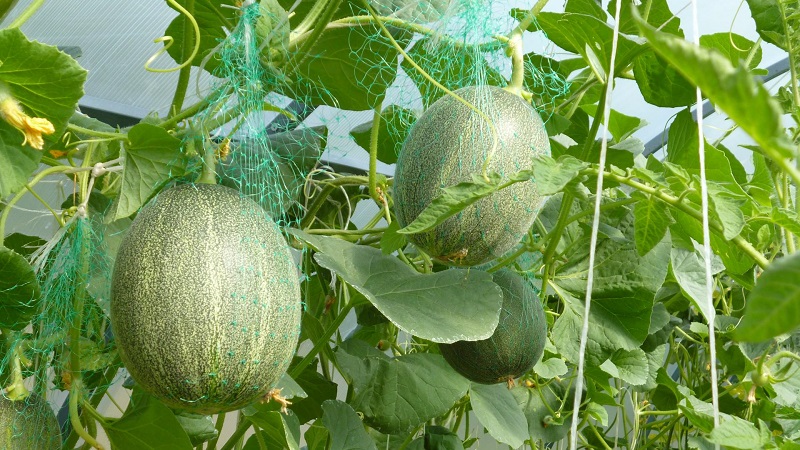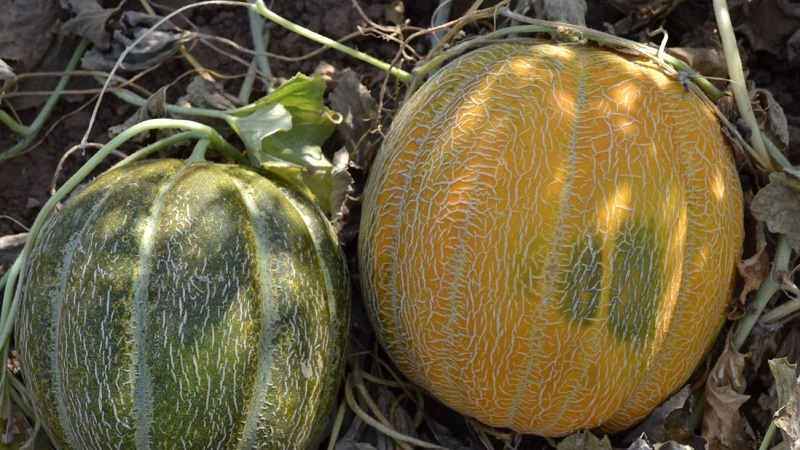When melons ripen and how to correctly determine their ripeness
In August 2018, the Cantaloupe melon weighing 29.89 kg was included in the Guinness Book of Records. The US record holder looked appetizing, although she had an uneven coloration.
In the vastness of Russia, the fruits do not reach such sizes, but with an effort, you can grow sweet and tasty fruits here. In the article we will find out when melons ripen and what parameters affect this.
The content of the article
How long does a melon ripen
The ripening period of the crop of this heat-loving culture lasts from 45 to 100 days.
What determines the rate of maturation
Melon ripening time depends on climate, varietal characteristics and growing conditions.
In the Krasnodar Territory, a melon can ripen in mid-July right in the field, and in Siberia, a fragrant product grown in closed ground begins to be enjoyed only in August.
 In hot summer, ripeness may come a week earlier than the date indicated in the instructions. But if the spring was cold, and the summer was cool and rainy, then the harvest will mature longer or deteriorate.
In hot summer, ripeness may come a week earlier than the date indicated in the instructions. But if the spring was cold, and the summer was cool and rainy, then the harvest will mature longer or deteriorate.
But even in an ideal climate for these fruits, the onset of ripeness largely depends on the cultivation technology (irrigation regime, fertilization, formation and rationing, etc.).
When melons ripen
Growing melon on their plot, gardeners know approximately how much the fruit of this plant ripens. However, the exact ripening period depends on many factors.
Variety
The variety of melon varieties allows you to choose the right one for any region. They are:
- early ripe - ripen in July;
- mid-season - ready for use in August;
- late ripening - harvest in September.
Region
In the southern regions, melons grow well in the fields, and the harvest of early varieties there begins to take off already in the middle of summer.
In the middle lane, melons ripen later. Mainly early-maturing and not too large-fruited varieties are planted here.
The further north you go, the less the weight of the fruits will be, and the less sweetness they contain.... After all, this melon culture needs a lot of sun and warmth to acquire a rich taste and aroma.

When growing melons in cold regions, it is important to fulfill three conditions:
- Protect from late frosts in spring and form the plant correctly.
- Limit the number of fruit set (so that one melon grows on one lash).
- Conduct multiple feeding to accelerate growth (every 7-10 days).
Growing in a greenhouse
Seedlings are transplanted into greenhouses in late April - early May. The harvest ripens in 2-3 months, depending on the variety and microclimate. Providing suitable conditions in the greenhouse and making an effort, you can get juicy and fragrant fruits even in Siberia.
Open ground
In temperate climates, seedlings in open ground planted in late May - early June, when there is no threat of frost. At the same time, the crop often has to be removed in August unripe and left to ripen at home.
In the south, the melon is harvested from fields and vegetable gardens fully ripe from July to September (depending on the varieties planted).
How to tell if a melon is ripe

Melon fruits of the same variety can ripen at different times in the same garden. Therefore, it is so important to be able to determine their ripeness.
First, the approximate ripening time is calculated (according to the instructions on the seed bag), then the development of the fruits in the beds is visually observed.
Methods and criteria for determining maturity
How to know the ripeness of a melon? Pay attention to these signs:
- Characteristic fragrant aroma... Ripe vegetables are characterized by a pronounced honey, pear or vanilla smell. Unripe specimens have no aroma. And overripe melon pulp does not smell very pleasant.
- Appearance. The peel must be firm, with a uniform color inherent in a particular variety. When examining, make sure that the fruit is free of mechanical damage, multi-colored spots and rotten areas.
- When pressed the peel of a ripe fruit is slightly springy (no dent on the surface).
- Patting sound. If you pat on the sides, you hear a dull sound, then the melon is ripe. An immature sound will be sonorous.
- The fruit is easily separated from the stalk, which dries up by the time of ripening.
Tips from experienced summer residents
In order for the melons to grow beautifully shaped and ripen faster, the formed green fruits are occasionally turned over in the beds. With this uniform sunlight, the skin acquires a uniform color from all sides.

Sugar content and juiciness of melons will be given by timely feeding. Half of the nitrogen fertilizer rate is applied at sowing, and the second part - when the fourth true leaf appears.
It is optimal to pick ripe melon fruits in the morning, before the heat begins, or late in the evening.
Winter or mid-late varieties are harvested at the stage of technical ripeness. During storage, they gradually ripen, while their taste and aroma are significantly improved.
When growing melons for sale, you should not pick them at the stage of biological ripeness, because during transportation they will quickly deteriorate. For transportation, slightly unripe specimens are selected, while maintaining the stalk.
Early varieties plucked fully ripe and immediately eaten -are kept they are no more than a week.
Conclusion
If you take into account the factors that determine the rate of ripening, and follow the rules for cultivating melons, you can get a sweet melon crop even in the middle zone of our country. And the degree of ripeness can be easily checked by the aroma, uniform color, elastic skin and a dull sound when tapping on the selected melons.